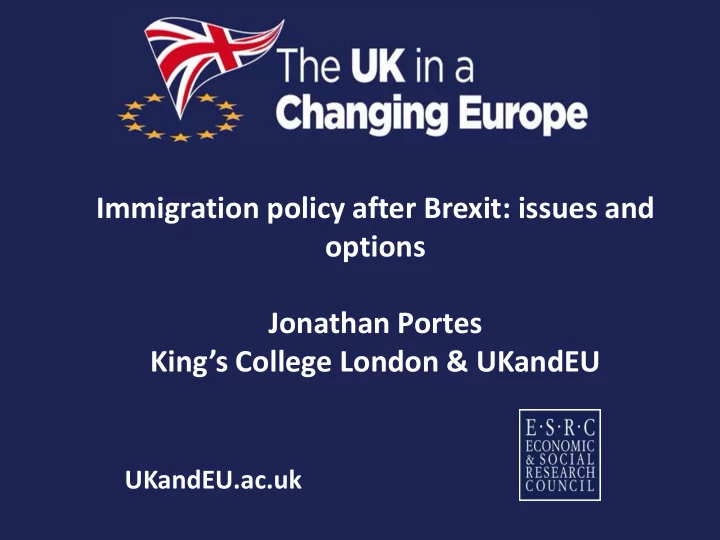

Immigration policy after Brexit: issues and options Jonathan Portes King’s College London & UKandEU UKandEU.ac.uk
Current system • Free movement for EEA citizens (right to move to work, seek work, self-employment, or self-supporting; very limited restrictions) • Skilled workers from non-EEA countries: Tier 2 (quota, salary/qualification restrictions), intra-company transfers (no quota, high salary threshold) • Family visas for spouses of UK citizens (income threshold) • Students • Asylum/refugees
Options for a new system • Points- based, “Australian - style”, “non - discriminatory” system (Vote Leave) • Modified free movement (EEA or Switzerland) • Work permit based system
Vote Leave “we will create a genuine Australian -style points based immigration system. ..Those seeking entry for work or study should be admitted on the basis of their skills without discrimination on the ground of nationality..”
Modifications to free movement • “emergency brake” (overall limit on work related migration) • Labour market restrictions (need a job offer; national preference in some circumstances) • Benefits/access to public services (extension of Cameron “renegotiation” proposals)
Work permits: current system • Skill, qualification and salary thresholds • Shortage occupations • Overall quota for Tier 2 skilled workers • Intra-company transfers (no quota) Expensive and bureaucratic (& becoming more so) •
Key issues for new work permit system • New system or modified version of existing one? • Level and scope of overall quota(s) • European preference? If so, via separate quota or different thresholds? • Sector-based schemes? If so, coverage?
Sector based schemes: pros and cons Pros: • Responds to sectoral lobbying • Could support industrial strategy • If done via intermediaries, could reduce bureaucracy Cons: • Central planning – Whitehall capacity • Administrative issues – sector definitions, borders, switching • Quota reallocations/misallocations • Regional issues
“Border control” not central issue • Unlikely UK will treat EU nationals worse than US or Australian nationals for border control/visa purposes • EU nationals will have (largely) free entry to UK (as US/Australians do now) • Change will be to right to work: enforcement will be in workplace/by employers (as well as landlords, public services etc) • Multiple different categories of EU nationals post-Brexit: employers will need to establish which and discriminate betweent them
A regional visa system? - Administratively feasible (given enforcement at employer level) - Border issues (workplace vs. residence, etc) - Raises similar issues to sector-based schemes - Role of Welsh government/LAs/business - Needs to be embedded in coherent national level framework
Transitional issues for resident EU citizens No easy way to identify eligibility: not just a question of picking a cut-off date: – No population register – No comprehensive database of entries and exits Possible options – National Insurance numbers – “Light - touch” version of existing process Whatever approach is chosen will be problematic: – Long period of uncertainty: tough for individuals, bad for business – Hard cases either side of the line – Resource implications
Immigration and post-Brexit trade deals • Status of EU nationals living in UK/Brits abroad falls within Article 50 • Unclear if post-Brexit migration flows will be part of negotiations (not significant in eg CETA). What can we offer? • Migration of skilled workers (ICTs, etc) already scuppered UK- India deal • Likely to be part of negotiations with Australia/NZ/Canada – but political roadblocks
Impacts • Likely impacts: – Reduce flows of both skilled and unskilled workers – Increase regulatory burdens on business – Increase bureaucracy/size of the state – Increase illegal working • But magnitude of these impacts will depend critically on design and implementation of new system: – how open/“closed” new system is overall – administrative aspects of new system – Burdens on employers/public services – Degree of deterrence/disincentive to EU migrants (especially skilled)
Other issues • Students – visa regime and fees • Self-employed • Family – will same rules apply to EU and non-EU spouses of UK nationals? • Asylum
Immigration policy after Brexit Jonathan Portes NIESR & UKandEU UKandEU.ac.uk
Annex: Estimating macroeconomic impacts • Estimate determinants of EU migration to UK • Construct illustrative scenarios for impact of Brexit on EU migration • Use existing estimates of the economic impacts of migration on growth, productivity and wages • Derive estimates of impact of Brexit-induced reductions in migration. [Forte & Portes, 2017, forthcoming]
Short term compositional impacts
Longer term macro: growth and productivity
Impacts on GDP, GDP per capita, & wages GDP: reduction of 0.6 to 1.3% by 2020 GDP per capita: reduction between 0.2% and 0.8% by 2020 and between 0.9% and 3.4% by 2030 Wages in low skilled service sector: increase of 0.12% by 2020 and 0.5% by 2030 (partial equilibrium) [All these for our central scenario; impact of more extreme scenario would be around 50% larger]
Recommend
More recommend